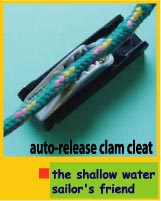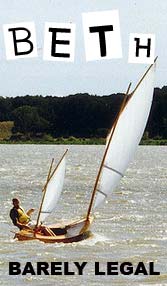
(click images to enlarge)
Boats around 8 m (27 ft) are most interesting for the average sailor. The harbor fees, maintenance
work, car if the boat is in the limits for road transport and the costs to buy but sure to build* are
still in the range of affordability.
So I have more designs in this range. The DUO 800 trailer catamaran was designed 1989. Many
where built. Outstanding journeys as far as Norway (route also on the North Atlantic side) where
made. The story of the boat is not finished, some are still under construction. So the plans stay in
my portfolio of standard designs.
The demands of today are different. The new DUO 800 S reflects this. Example toilet. The "toilet" in the DUO 800 is a hole in the nacelle. Very efficient, no smells, no repairs. In many countries the
are forbidden now. So there is in the new design a separate bathroom with a toilet. The fair sex will
appreciate the new setup. The load capacity in relation to the whetted surface is better for
symmetrical hulls. People carry now more stuff so I changed to symmetrical hulls. Because of this
change the boat is now faster under low wind situation. This is by the way, in my eyes, the only
drawback from asymmetrical hulls. The carrying capacity is almost doublet and now 670 kg
(1475 lb).

The new designed nacelle has an almost stealth shape. I dit this not as a gimmick but to decrease the
construction time. I think also it looks cool. The nacelle is a bit bigger without increasing the
weight. By the way, nobody complained about the inside space of the DUO 800 cabin.
The hulls have a trapezoidal cross section. I use this shape a lot. The boats are fast, because of the
relative low whetted surface. If correct designed the do not pound. The entrance is a tulip shaped V.
Which means much dynamic lift on the bows. The never dive! I chose dagger boards this time. I dit
this because this will be a very fast boat. So the apparent wind angle changes quickly forward. The
boat sails on the wind. To take the most profit a low leeway angle is important and dagger boards
the best means to accomplish this. The plans show a way how to build them the easy way. (See also this article).
The DUO 425 was my first catamaran with a biplane rig (1985). This boat was and is a big success.
For my self the most fun boat to sail. After this success story I designed the DUO 800 for the biplane rig. Unfortunately, carbon masts in this time dit not exist, the wooden I designed where not so easy to build. Carbon was very expensive in these days and difficult to get. So I re-designed the boat for a normal sloop rig. Almost all are built with this rig. Here an exception with the biplane rig. The boat was built in India.

Today the situation has improved. First of all you can now buy glass fiber flag poles. These are a
perfect base for the masts we need. Some layers of uni directional carbon and biaxial glass (for the
torsional load) and a finishing glass cloth layer will be sufficient. I have you, as Duckworks reader,
not to tell how much money can be saved with a rig without additional rigging.
The modern free standing rig was developed by Mr. Ljungström 1936. He used double layer sails on
a free standing mast without a boom. The mast could rotate to furl and unfurl the sail(s). Today you
see more boats with this rig. Having no boom is a big safety feature of course. The biggest boat
with this rig was the "Tesla", length 13,5m, sail area 84 m2. He used a "vertical" sort of traveler on
some of his boats. A nifty feature to trim the sail. Just visible on the photo below.

Here the lay out of the DUO 800 S

The settee in the nacelle is 2 m wide and 1,565 m deep. Over the day a roomy settee for up to six
persons at night a comfortable double berth. There is a lot of half height lockers. Because of this the
room looks bigger as it is. The hanging locker can be omitted, perhaps for a chard table. There is an
other hanging locker in the starboard hull. The height in the nacelle is from 1,4m at the entrance to
the minimum height of 0,98 m above the seats in the front.
Each hull sports a cockpit. Each cockpit has also a tiller. Because of the cockpits I propose to use
only trampolines in between the hulls. The lay out shows no front trampoline. But there are
drawings for a front beam and connectors in the drawing set.
Each sail has 19,2 m2 (about 207 square feet). The masts rotate in gravity/Epoxy deck bearings,
which are easy to made (is described in the plans). The furler is made from plywood disks and
Epoxy. These is direct glued to the mast. Furling and unfurling the sails is done from the safety of
the cockpit(s).
| SPECIFICATIONS |
| Loa, Lwl |
- |
8.25 m |
| Draft |
- |
0.28 m |
| Beam C/C |
- |
4.20 m |
| Beam total |
- |
5.02 m |
| Draft |
- |
0.40 m |
| Draft dagger board down |
- |
1.39 m |
| Weight empty |
- |
830.00 kg |
| Weight max. CWL |
- |
1500.00kg |
| Sail area parallel rig |
- |
34.60 m2 |
| L : B ratio hulls |
- |
1 : 18,5 |
| L : B ratio boat |
- |
50 % |
| Max. righting moment (RM) |
- |
3900 kgm |
| Max.speed windspeed |
- |
21.72 kn, 20.63 kn
(computer prediction) |
| Auxiliary outboard engine |
- |
10 HP |
| Construction time |
- |
900 hours |
As mentioned earlier the boat is, as all my designs a ply(wood)/glass/Epoxy composite
construction. Still the most cost efficient to build a light and strong and almost maintenance free
boat. One of the best parts of the system is that you as amateur can check your work thoroughly to
give you confidence in your work and later at sea.
As for my other designs the beams are standard Aluminum tubes. These are connected with
stainless steel clamps to the hulls. Setting up the boat will take about 2 hours. The most time will be
needed to stretch the trampolines. On the trailer the boat stays in the legal limit of 2,44 m (8 feet)
width.

Bernd Kohler - Maisons 04/09/2014
*The construction time for the DUO 800 S is about 900 hours. When you can work 17 hours a week
on the boat, the boat is ready after one year.
Plans available from Duckworks Here
Other plans by Bernd Kohler are found Here
|












